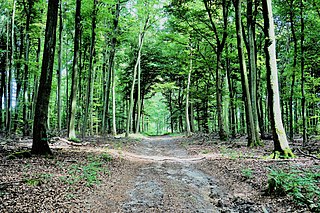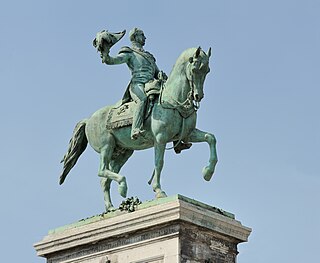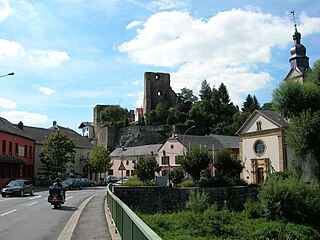
Luxembourg, also known as Luxembourg City, is the capital city of the Grand Duchy of Luxembourg and the country's most populous commune. Standing at the confluence of the Alzette and Pétrusse rivers in southern Luxembourg, the city lies at the heart of Western Europe, situated 213 km (132 mi) by road from Brussels, 372 km (231 mi) from Paris, and 209 km (130 mi) from Cologne. The city contains Luxembourg Castle, established by the Franks in the Early Middle Ages, around which a settlement developed.
Lycée Vauban is the French High School located in Gasperich, a quarter of Luxembourg City, in southern Luxembourg.

The Grünewald is a forest in central Luxembourg, most of which is owned by the national government. Grünewald stretches through the communes of Niederanven, Steinsel, and Walferdange; the centre of the forest is situated 6 kilometres (3.7 mi) north-east of central Luxembourg City. As a result of its proximity to Luxembourg's capital city, it is a popular destination for tourism, leisure, and hospitality. Within the Grünewald are the sources of the Black Ernz and the White Ernz.

The Duchy of Luxemburg was a state of the Holy Roman Empire, the ancestral homeland of the noble House of Luxembourg. The House of Luxembourg, now Duke of Limburg, became one of the most important political forces in the 14th century, competing against the House of Habsburg for supremacy in Central Europe. They would be the heirs to the Přemyslid dynasty in the Kingdom of Bohemia, succeeding the Kingdom of Hungary and contributing four Holy Roman Emperors until their own line of male heirs came to an end and the House of Habsburg got the pieces that the two Houses had originally agreed upon in the Treaty of Brünn in 1364.

The Monument of Remembrance, usually known by the nickname of the Gëlle Fra, is a war memorial in Luxembourg City. It is dedicated to the thousands of Luxembourgers who volunteered for service in the armed forces of the Allied Powers during both World Wars and the Korean War.

Fort Thüngen is a historic fortification in Luxembourg City, in southern Luxembourg. It is sited in Dräi Eechelen Park, in the Kirchberg quarter, in the north-east of the city. It is also colloquially known as Three Acorns in reference to the acorns that sit atop each of the three towers.

Saint Michael's Church is a Roman Catholic church in Luxembourg City, in southern Luxembourg. It is located in Fishmarket, in the central Ville Haute quarter.

The National Museum of Natural History is a natural history museum in Luxembourg City, in southern Luxembourg. The museum is located in the Grund quarter on the eastern bank of the Alzette river, next to the Neumünster Abbey cultural centre.

The National Museum of History and Art, abbreviated to MNHA, is a museum located in Luxembourg City, in southern Luxembourg. It is dedicated to displaying artworks and artefacts from all epochs of Luxembourg history. The museum is situated in Fishmarket, the historic heart of the city, in the Ville Haute quarter.

Place Guillaume II is a town square in Luxembourg City, in southern Luxembourg. The square lies to the west of Krautmaart and to the north of Boulevard Franklin Delano Roosevelt in the heart of Luxembourg's historic Ville Haute quarter. It is colloquially known as Knuedler, from the Luxembourgish language's word for 'knot', referring to the knot in the belt worn by Franciscan friars.

Luxembourg City Hall is the city hall of Luxembourg City, in southern Luxembourg. The city hall is the centre of local government, including being used as the private office of the Mayor of Luxembourg City. Due to its position in Luxembourg's capital, it also regularly plays host to foreign dignitaries. It is located on the southwestern part of Place Guillaume II, the main square in the centre of the city.

Villa Louvigny is a building in Luxembourg City, in southern Luxembourg, that served as the headquarters of Compagnie Luxembourgeoise de Télédiffusion, the forerunner of RTL Group. It is located in Municipal Park, in the Ville Haute quarter of the centre of the city.
Am Tunnel is a contemporary art gallery, situated in a tunnel in Luxembourg City, in southern Luxembourg. The gallery is located in part of the underground casemates of the city's ancient fortress, under the Bourbon plateau, in the northern part of Gare quarter. It is connected to the former headquarters of Banque et Caisse d'Épargne de l'État (BCEE), the third-largest bank based in Luxembourg.

The Judiciary City is a site in Luxembourg City, in southern Luxembourg, that houses a number of courts and legal offices. It consolidates all of Luxembourg City's judicial buildings, except those related to the institutions of the European Union, on one site, and greatly expands their capacity.

The Bock is a promontory in the north-eastern corner of Luxembourg City's old historical district. Offering a natural fortification, its rocky cliffs tower above the River Alzette which surrounds it on three sides. It was here that Count Siegfried built his Castle of Lucilinburhuc in 963, providing a basis for the development of the town which became Luxembourg. Over the centuries, the Bock and the surrounding defences were reinforced, attacked and rebuilt time and time again as the armies of the Burgundians, Habsburgs, Spaniards, Prussians and French vied for victory over one of Europe's most strategic strongholds, the Fortress of Luxembourg. Warring did not stop until the Treaty of London was signed in 1867, calling for the demolition of the fortifications. Ruins of the old castle and the vast underground system of passages and galleries known as the casemates continue to be a major tourist attraction.

Bettendorf Castle is located in the village of Bettendorf in eastern Luxembourg. While there appears to have been a castle from the 13th century, today's Baroque building dates from 1728 and was restored in 1962. The castle is privately owned and is not open to the public. In 2007, the castle and its parkland, were added to Luxembourg's national register of classified monuments.

Hesperange Castle is a ruin located high above the town of Hesperange in southern Luxembourg.
The following is a timeline of the history of Luxembourg City, Luxembourg.

Musée Dräi Eechelen is a museum in the Kirchberg district of Luxembourg City in the Grand Duchy of Luxembourg. Opened in July 2012 in the fully restored 18th-century Fort Thüngen, its permanent exhibition traces Luxembourg's history from 1443 to 1903.
















